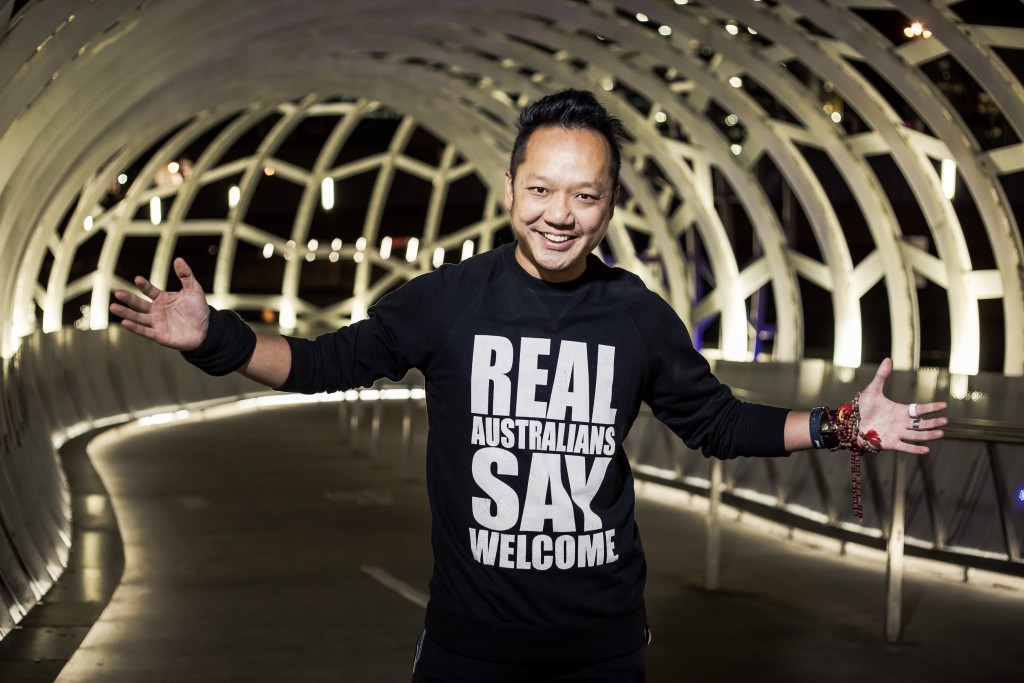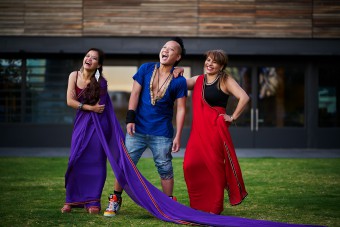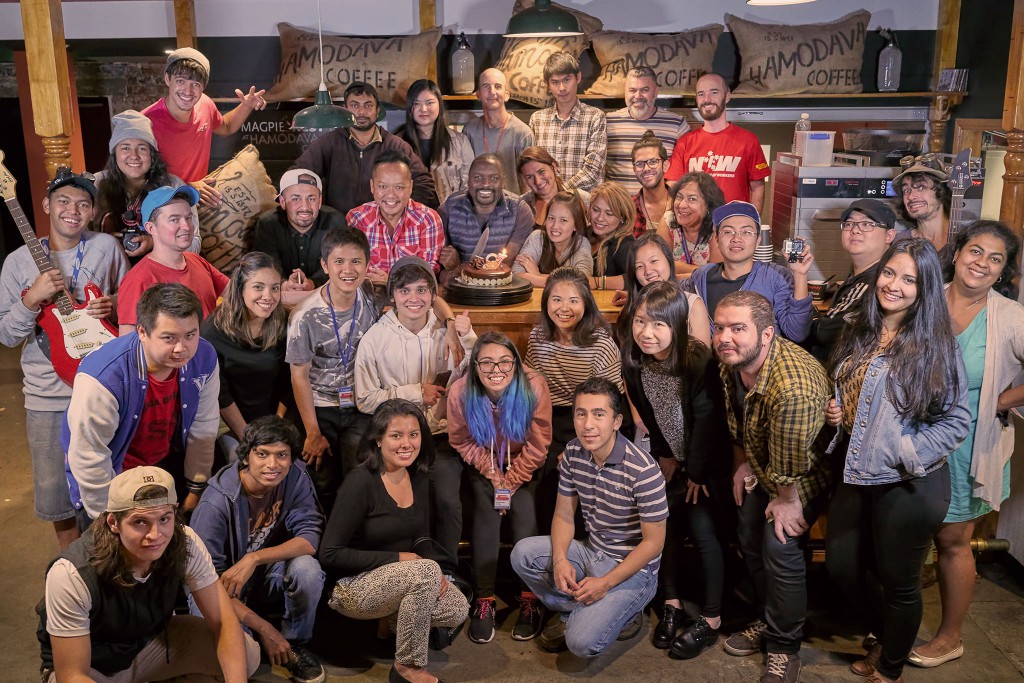“Spot for the Asian with the mohawk in a black coat.”
I wait in the warmth of the café. Gary Lee, New Australian of the Year, arrives and in the same breath of greeting, cajoles me into accepting a coffee. Gary is of average build and—an Asian with a mohawk. On his black coat’s left lapel are four or five pins, bearing the symbol of various social justice organisations and causes. We settle down at the table—his presence is quiet but alert, patiently waiting. We begin talking, getting used to one another, rehearsing the intimacy of old friends, relaxing into the social dynamic of interviewer/interviewee.
This year, on the 21st of January, Gary Lee was awarded the title of New Australian of the Year.
‘New’ Australian of the Year:
- my first thought had been that the Australian of the Year council had replaced current Australian of the Year, David Morrison.
- my second thought – as a Chinese-Malaysian – was that it felt good to have a Chinese-Malaysian, Gary Lee, recognised as “Australian”—and what’s more to be given the highest honour in the land to the truest, bluest, fairest dinkum of them all.
However, New Australian of the Year is a completely different award to the Australian of the Year. The award, established in 2014 by the Australia Day Council, is a title celebrating new migrants and refugees and their contributions to the Australian community.
Fifteen years ago, Gary Lee—reluctant migrant and this year’s recipient—arrived in Australia to study at RMIT. He was hesitant to leave the networks he had in Malaysia, where it was comfortable, safe. Yet, in the three days after arriving in Australia, Gary finds Voices magazine on RMIT’s campus: “They were doing a call-out for office bearers,” Gary diverges from this thought, “I’ve always been active in high school…I remember filling in that form and walking into the office in early January.” He laughs sheepishly, embarrassed by his enthusiasm. Gary recalls the president of RMIT’s Association of International Students being taken aback by his early nomination. And in Gary’s words, “The rest is history.”

From that point on, Gary has taken a keen and energetic approach to his advocacy work with the City of Melbourne as the International Student & Youth Officer. But the full scope of Gary’s work supersedes his title—Gary is involved with various community integration projects such as Welcome Dinner Project, The Couch, and Poise’n Bollypop – on top of numerous other commitments that have grown out of the New Australian of the Year award. It becomes clear that work and personal are intertwined, and these inform one another for Gary.
Gary is keen to tell me about Poise’n. The dance group formed, fifteen years ago – for the first time, during the annual multicultural festival, “World Week”, run by the RMIT Association of International Students: “One of our friends from East Malaysia had said, ‘Let’s do a dance’—none of us…had ever danced. I still remember it was Mariah Carey…” We both laugh, “It was Fantasy. She was cool then! That’s very hip-hop.” Gary cites a unique connection that he and the other members of the group felt through dance: “We had different friends from all over the world that could get together based on something that we liked.”

Ten years later, the amateur crew breaking down to Mariah Carey, has transformed into Poise’n Bollypop. In 2011, Gary and a few students from RMIT, established Poise’n Bollypop—a collective of dancers who perform a fusion of Bollywood and hip-hop dance at cultural events. The endeavour began as a place for students (mostly international students) to get together in the monolithic and sometimes alienating institution that is university campus and – Gary admits -integration into other parts of Australian life has almost been an accidental part of the group’s forming together. In travelling around and performing at different cultural events, in different locations—whether at Federation Square or housing estates, “Australia” as “the West” slowly unravels and students begin to see who actually inhabits the space. “I find that an accidental benefit of starting with the dance crew…is that I want them to share what I am passionate about.” So while Posie’n Bollypop has no political agenda, it is clear that Gary’s involvement influences the students involved with the crew, with some going on to volunteer with Gary in other areas. “With Bollypop, I feel like they become my little army.”
Each of Gary’s projects is aimed at integrating International students with the ‘true’ cultural landscape of “Australia”. Earlier in our conversation, Gary highlights one of the issues of living as an international student: “I think a lot of international students feel… they don’t feel part of it because they don’t fit the puzzle.” For Gary, becoming a part of the flow of social life in Australia is “contributing” and learning more about the place.
But adjusting to a new country isn’t just about feeling like you “fit in” by “helping out”—working out where you fit on Ford’s production line of model citizens. Coming to a new country is about seeking out family, where your own family may be continents away. With some of the City of Melbourne projects, there are opportunities for students to locate themselves within a community. Gary cites an, not uncommon, experience one student had while volunteering at the Seniors’ Christmas Lunch: “She said, ‘I sat down with the lady next to me, she wanted to find out more about me—I don’t have that connection with someone older here; I don’t have an aunt, I don’t have my mum, I don’t have my grandma.’…and they broke down over that simple connection, because you forget it is very lonely.”

Along with opportunities like the Seniors’ Christmas Lunch, the council supports The Couch, a space for international students. Founded and run by The Salvation Army to combat the alarming rate of international students “sleeping rough”, the space is staffed by local and international volunteers who provide support for the eighty to hundred students that turn up every night. Events like salsa classes, day trips, English classes, are volunteer-run and based on the interest of those who attend. In addition to the social aspect, there is a free meal offered to all students and while that sets up a kind-of structure for social interactions, according to Gary, this meal is more than that for some: “They’re not homeless per se but they need a warm meal… some are hungry, some who can’t cook, some who want to save on food so they can go and buy a little beer with afterwards; we think these are all important and how friendships are made.” And these things are important, and initiatives like The Couch enable students, in a small way, to connect, form relationships, and perhaps relieve the stress of the enormous cost of living.

Gary continues, “Another project that we are really passionate about is The Welcome Dinner Project.” The Welcome Dinner Project, run in conjunction with Joining the Dots, initially began as a program for asylum seekers. The group eventually evolved to include international students “as international students have similar challenges—in engagement, connection with local families,” says Gary. The project involves “local Australians” who offer their homes as host for one of these dinners—and Joining the Dots connects these hosts with “established Australians” and “new Australians” who will meet up for a meal. Each attendee brings a plate that means something to them, and conversation focuses on what the particular dish means to them: “When dealing with asylum seekers and refugees, they try to avoid questions like ‘Where do you come from?’ or ‘How did you get here?’ or ‘Do you work?’… so it is about food.” Connecting with local families allows students, and asylum seekers, to form relationships in their local area and find community support in an alien land. “I love the Welcome Dinner Project because it says – Move on, let’s talk about each other.”
In Gary’s work, universal experiences—like food—are used to draw recognisable connections between cultural groups. However, creating bonds through the universality of experience is often a preemptive—what about confronting racism? Gary pauses for a moment, “I don’t know if I have an answer.” Thinking out loud, Gary ruminates on the conversations had with the colleagues about international students and employment, and then diversity in positions of power. He is contemplative about whether it is racism and a “bamboo ceiling” or whether it is that Asians lack the skills necessary to be in positions of power. “I don’t know where to draw the line, and I personally am used to it, but I get annoyed…” Gary begins to address micro-aggressions—as all conversations on race naturally tend to the minute, visible moments of micro-aggressions in a person of colour’s life: “I think they’re being polite but I don’t know where you’re taking that conversation…” Gary is diplomatic in his ambivalence, “I am limited to what I can do or what I can say for the City of Melbourne, but outside [the job] I feel like that’s my role—to ask the questions.” And as New Australian of the Year, Gary cites instances where the award has given him a platform to discuss issues of race and inclusiveness in Australian culture.
“True understanding”, in Gary’s words, is at the heart of his work and advocacy. For Gary, cultural diversity is not just about “opening the door” for new migrants to come in (Is Australia opening its doors?) but about how communities support them once they arrive. As an example, Gary begins to talk about his work with sporting clubs, as a Melbourne Victory Football Club Ambassador, saying, “A lot of rural Victorian clubs say ‘We open our clubs to everyone,’ then you have some Muslim people that come in and play footy, then every Friday you go to the pub,” implying going to the pub would exclude a Muslim player who chooses not to drink, “Maybe once in a while, you could do something not alcohol-related?” Gary comes back to the notion of true understanding and stresses the need for one-on-one conversation.
And through cultural communication comes cultural understanding—for the WASP, Gary believes that cultural understanding can be procured through your own cultural lens. Using fusion cuisine, Gary explains trying to approach a cultural relationship through a “fusion” of cultures:
“How many of you have gone to fusion restaurants, like Chin Chin and Mamasita? So, you love that, right? It’s Asian cultures fused, to modernise it—so that we can have wine next to it. But all of a sudden, you understand it. So why can’t you do the same thing with cultures?”
Gary’s tireless efforts to push cultural communication into the centre means he is always on the go, flitting from meeting to meeting—he tells me that on Monday he will be at the opening of The Couch at its new location. I begin to see why it is difficult to tease out a coherent resumé for Gary: when you are involved with diversity politics, it feels like it bleeds into every page of your life, and boundaries between Gary’s personal and political are definitely blurred: “The boundaries are blurred because I’m passionate about it,” he pauses for a moment, and starts on the support his team and work allows him to do. But Gary’s optimism is evidently what fuels his projects, “I always like to do things extravagantly… This is who I am, whatever I do I want people to remember it.” There is a particular joy that Gary takes in dealing with the otherwise difficult terrain of race—from dealing with homelessness and perilous living conditions that international students face to calling for members to white Australian society to look in and be a part of the conversation—this passion is the impetus for new projects in the name of cultural diversity.
“I’m not popular, I’m not famous, I’m not a superstar. But I want it so much, I think it will happen – in small ways… I often get questioned too, ‘Why don’t you want to be a director or business, a CEO?’ Then I feel I would be disengaged…and I would lose that human connection.”
Gary is on the frontline because he yearns for that human connection. So what’s next for Gary? “At the moment, I don’t know – it would kill me if I go to work and I [only] see colleagues…” And he turns to me in a personal moment of contemplation, “Is this holding me back? Or is it time for me to move up? I don’t know if it’s fear… Can you send me a 300 word answer?”
With this award, it seems like Gary is being pushed to think about his role in politics. While the title of “New Australian of the Year” rightly recognises Gary’s hard work and dedication to international students and the wider community, it’s definitely a “and other” category – will migrants, even those who, like Gary, have been here for fifteen years still be considered “new”? Gary’s efforts involving cultural communication and social integration has made a difference in the lives of international students he meets. He has worked hard for all that he has accomplished, and maybe – he should deserve a shot at being Australian of the Year.
